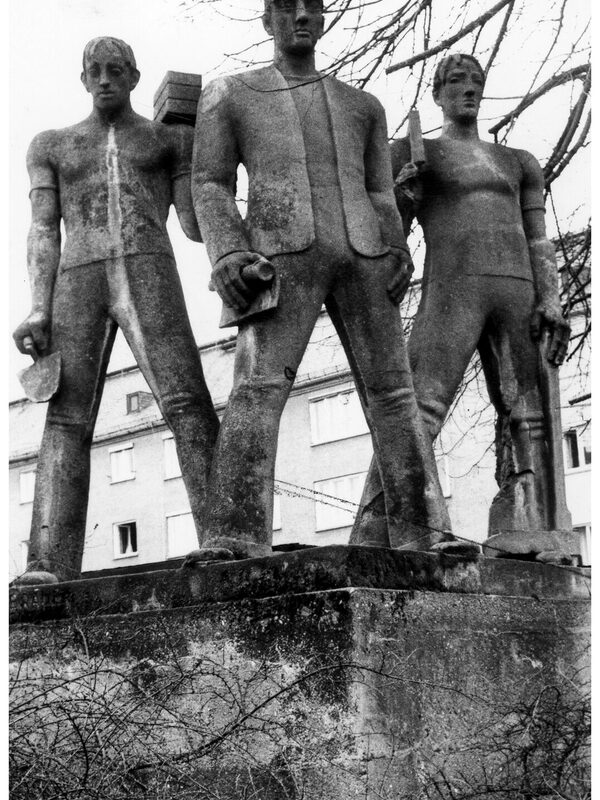Brewer, Carl Wilhelm
Brewer, Carl Wilhelm
Sculptor
born: 08.08.1881 in Bierstadt
died: 23.10.1962 in Wiesbaden
Carl Wilhelm (Willy) Bierbrauer was orphaned by the early death of his parents, who lived from farming, and grew up in Bierstadt with his grandmother. His artistic talent became apparent at a young age. He completed his training in Frankfurt from 1900 to 1904 under Professors Ferdinand Luthmer (1842-1921), Director of the School of Arts and Crafts and the Museum of Decorative Arts, and Friedrich Christoph Hausmann (1860-1936), head of the modeling class at the School of Arts and Crafts and the sculpture class at the Städel Art Institute from 1892 to 1905.
After Bierbrauer had already contributed a frieze to the façade of the Landeshaus in 1906, he undertook a study trip to Italy in 1909, where he studied the tradition of European sculpture. Back in Wiesbaden, he created the frieze depicting a funeral procession in the portico of the South Cemetery's funeral hall, inaugurated in 1911, an early major work that Bierbrauer himself considered to be one of his most important works. This was followed by the Gutenberg monument at the Nassau State Library and twelve larger-than-life portrait medallions of deserving personalities for the extension to the Nassauische Landesbank, now the Nassauische Sparkasse, which was built between 1914 and 1916.
In 1915, Bierbrauer designed the "Iron Siegfried" on behalf of the Wiesbaden District Committee of the Red Cross. The almost four-metre-high nail statue made of lime wood, which has been preserved to this day, stood in a pavilion on the Bowling Green from 1915 to 1918. Patriotic-minded citizens could hammer in nails of varying prices in return for a donation to the war chest. The campaign is said to have raised 2.5 million gold marks.
Bierbrauer became known beyond Wiesbaden through his frequent successful participation in competitions. In 1932, for example, he submitted a design for the planned but unrealized Imperial Memorial to the Fallen of the First World War in Bad Berka near Weimar, which was one of the 20 award-winning proposals submitted for further work out of a total of 1828. On the other hand, numerous monumental memorials and monuments as well as tombs and realistic, lifelike portrait busts and sculptures contributed to his success. These included the war memorial in Usingen (1924), the so-called Monument to Labor (1932) on Loreleiring in Wiesbaden and the Lion Fountain in Idstein (1937).
Bierbrauer, who always endeavored to meet the expectations of his clients, even in his choice of style, was apparently able to continue working successfully during the National Socialist regime. As can be seen from an article in the Nassauer Volksblatt of August 7, 1941 on the occasion of Bierbrauer's 60th birthday, "a strong form-preserving attitude in the classical sense was appreciated in his entire oeuvre, an opposing attitude to the 'isms' of the last decades, to Expressionism and its pathological excesses". And so Bierbrauer was not short of commissions during this time either. He created the memorial in Idstein (1941), the base of which still exists, but whose martial group of figures was dismantled and smashed immediately after the end of the war. He also produced architectural sculptures such as the two monumental eagles for the Erbenheim military airfield and the former Thingstätte on the Loreley as well as several "Führer and Hindenburg busts" (Nassauer Volksblatt, 7.8.1941).
A bust of Hitler Bierbrauer stood in the fountain colonnade (Wiesbadener Tagblatt, 26.4.1937), another larger-than-life bronze bust in the Kurhaus and the municipal gallery also had one. (Nassauer Volksblatt, 7.8.1941). Bierbrauer also created the surviving death mask of Alexei von Jawlensky (1941).
A bronze bust of Goethe (1949) and a marble bust of Baron vom Stein (1952, since 1962 in the Hessian State Parliament; cast from 1963 in the new town hall), commissioned by the magistrate, date from the post-war years.
Bierbrauer was present in Wiesbaden's art scene until his death. From 1913 to 1933, he taught at the municipal school for craftsmen and arts and crafts (closed in 1934, reopened in 1947, Werkkunstschule since 1949). He was also committed to the interests and promotion of Wiesbaden artists, was a member of the Freie Künstlerschaft Wiesbaden founded by Otto Ritschl in 1925 and co-founder of the Ring Bildender Künstler, whose first chairman he became in 1949. In the same year, on the occasion of his 50th anniversary as an artist, he was also appointed honorary chairman of the Nassauischer Kunstverein e. V., which organized two exhibitions of his works in the Wiesbaden Museum in 1954 and 1961. On the occasion of his 75th birthday in 1956, he was awarded the Federal Cross of Merit on Ribbon.
Carl Wilhelm Bierbrauer's grave is located in Wiesbaden's North Cemetery.
Literature
- Hildebrand, Alexander
The portrait. Carl Wilhelm Bierbrauer. In: Wiesbaden International Issue 2, Wiesbaden 1981 (pp. 27-35)
- Saltenberger, Frank-Michael
Patriotic glorification. Carl Wilhelm Bierbrauer's war memorial in Usingen. In: Yearbook Hochtaunuskreis 14.2006, Frankfurt am Main 2005. (pp. 188-195)
- Munzel-Everding, Dietlinde
War nails. Wehrmann in iron. Nagel-Roland. Eisernes Kreuz, Wiesbaden 2008, supplements 2012. (pp. 9-11, 32-34, see: www.munzel-everling.de retrieved February 1, 2014)
